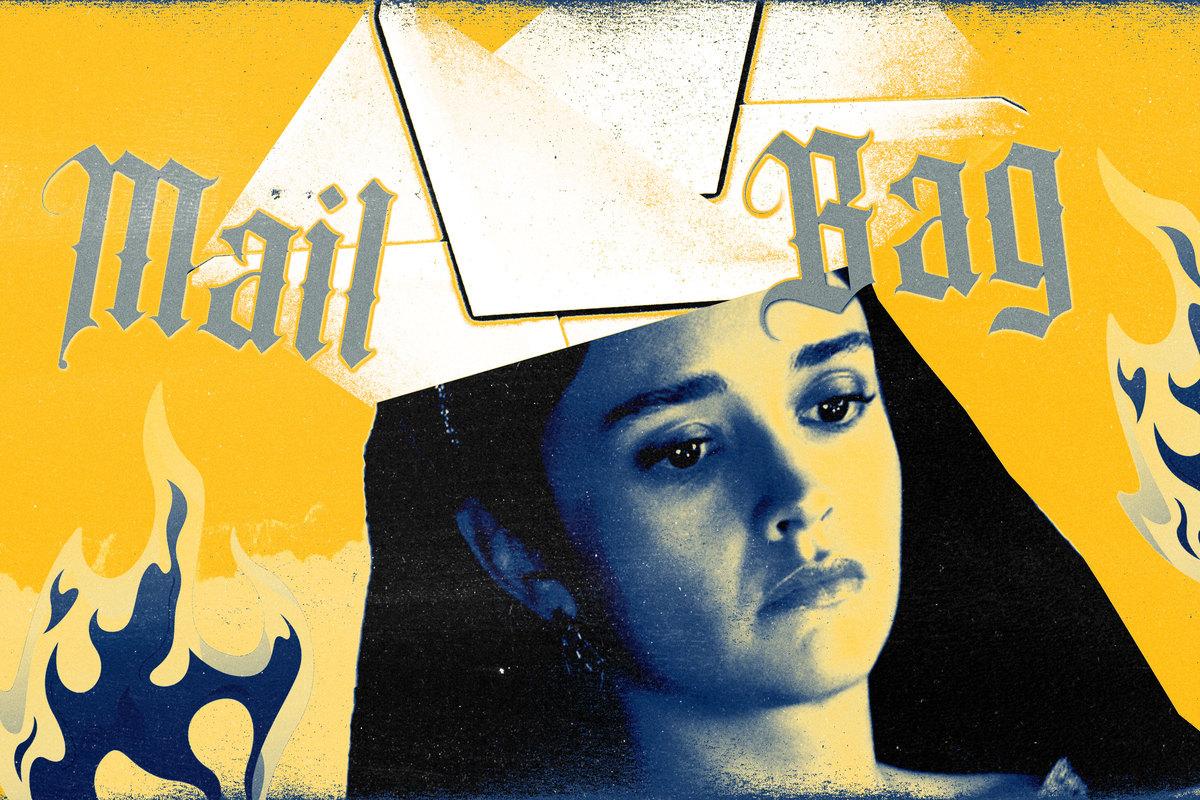‘House of the Dragon’ Episode 1 Mailbag: Septs, Sex, and Security
Spoiler-free answers to questions raised by the ‘Game of Thrones’ prequel’s Season 2 premiere, including info on Alicent’s hookups, Helaena’s visions, the Targaryens’ dragons, and more
House of the Dragon is back, and so are our weekly HotD mailbags. Today, we’re offering spoiler-free answers to your questions about Alicent and Criston’s surprising sex, Helaena’s prophecies, and more.
To appear in future editions, message me @zachkram on Twitter/X or at zach.kram@theringer.com each week after new episodes air.
Vickers asks, “How long do you think Alicent and Criston Cole have been doing it and do you think that was the cause for the complete lack of security in the Royal Quarters?”
I knew after watching “A Son for a Son” that much of the reaction to the Blood and Cheese incident would focus on the adaptation’s changes to Helaena’s role, as Dragon removes the Sophie’s Choice element present in Fire & Blood. But I didn’t expect so much chatter about how the show altered Alicent’s part: In the book, Alicent is bound and gagged so that she witnesses the murder of her grandson, while in the show, she’s busy coupling with Criston Cole.
A number of viral responses have criticized this change, but I don’t see it as the sort of unnecessary, nudity-laden sex scene addition for which Game of Thrones became known early in its HBO run. Instead, I think it could add a new layer to Alicent’s character. As actor Olivia Cooke told Variety, “It adds a level of shame and guilt that is different to anything that Alicent has ever experienced before, by being indisposed with the head of the Kingsguard who should have been on duty to make sure that the castle was on lock. That’s a theme that plays throughout the season: If they hadn’t embarked on this affair, would this have happened? They hold themselves accountable completely.”
So let’s take the second part of this question first, about whether Alicent and Criston are actually at fault for the lack of palace security. As my colleague Riley McAtee wrote after the episode, the Kingsguard usually runs seven men deep but—riven in two by the civil war—now counts just three members, including Criston. If one of those white cloaks is monitoring for enemy dragons above the city, as Arryk Cargyll does in “A Son for a Son,” that leaves just two remaining knights sworn to defend the royal family stationed in the Red Keep’s interior.
Perhaps the Lord Commander, knowing his ranks have thinned, should have been even more vigilant rather than sneaking off to the queen’s chambers!
As for how long the two have pursued their tryst, Alicent has crushed on Criston for two decades by this point in the story. Cooke told Elle, “This is someone that she’s fancied since she was a kid that Rhaenyra got to have.” And Emily Carey, who played the younger version of Alicent before the large time jump midway through Season 1, said that when Alicent learned Rhaenyra had slept with Criston, she thought, “Hold on. You slept with him, and I’m in love with him, and you know this. That’s not fair.”
But it seems more likely that Alicent would have waited to begin her dalliance with Criston until after her husband’s death. That might seem like a quick turnaround—Viserys can’t have been dead much more than a couple of weeks in the show’s timeline—but this isn’t a world in which characters wait long to find a new mate after their previous partner dies. Remember that Daemon hooked up with Rhaenyra on the beach right after his wife Laena’s funeral.
Cooke told Elle her interpretation, which is that Viserys’s death spurred her character’s initial hookup with Criston:
Viserys died and I don’t know, you never see it, but I’m imagining in the throes of grief and despair and also confusion, Criston Cole has always been there, and I think something just blossomed from that. I think when someone dies, it’s almost quite life affirming as well, in a way. Because you’re like, “Fuck, everything’s just so finite.” And I don’t know if the passion was born from that and just being like, “Let’s just seize the moment.”
Carpe diem, Alicent! Or, to use a Valyrian saying instead of a Latin one: After Alicent said to Viserys, valar morghulis (“all men must die”), she turned to Criston to command, valar dohaeris (“all men must serve”).
And while it’s easy to accuse the greens of hypocrisy, this clandestine union actually operates as an empowering moment for the new widow. It seems likely that Alicent’s relationship with Criston represents the first time in her life that sex has been enjoyable—note how her first encounter with Criston in this episode centers on her pleasure. Cooke said in an interview with Cosmo UK that while filming a sex scene, she was instructed to act like she was “into it,” with “more enjoyment.”
For Rhaenyra, by contrast, sex has always been about desire, from her seduction of Criston in her youth to her affair with Harwin Strong to her beachside romance with Daemon. It’s no coincidence that in Season 1, Episode 4, the camera cuts between Rhaenyra’s passionate kiss with Daemon in Flea Bottom and Alicent’s look of complete boredom in Viserys’s bed. “Fucking is a pleasure, you see. For the woman as it is the man,” Daemon tells Rhaenyra in that sequence—just before the show returns to Alicent’s utter lack of it.
Sarah asks, “Was Alicent praying in the sept that Cersei destroyed?”
In her stunning, irrevocable victory over the High Sparrow and Tyrells in the best Thrones episode, Cersei Lannister engineered the destruction of the Great Sept of Baelor. Fun fact: Baelor’s Sept was also the location of Cersei’s wedding to Robert Baratheon. She hated that marriage so much, it’s a wonder it took her so long to blow the place up.
But that isn’t the site of Alicent’s prayers in Dragon. Construction on the Great Sept of Baelor started during the reign of King Baelor the Blessed, a Targaryen who ruled about 30 years after the Dance of the Dragons, and finished years after his death.
Instead, a different sept is the chief place of worship in the King’s Landing of Alicent’s era. This one dates back more than a century before her time.
After Aegon won his war of conquest and decided to settle for good where he’d first landed on the Westerosi continent (thus the name “King’s Landing”), infrastructure started to spring up in the new city, which had previously been populated by forests and ancient ruins. From a religious perspective, first came a “modest” sept in King’s Landing, according to Fire & Blood, and then a second sept, “twice as large and thrice as grand,” whose construction was funded by the High Septon in Oldtown.
That second sept is presumably the one still in use at the time of this show. In the Dragon pilot, Viserys tells his first wife, Aemma, about his dream (emphasis mine): “It was clearer than a memory. Our son was born wearing Aegon’s iron crown. When I heard the sound of thundering hooves, splintering shields, and ringing swords, I placed our son upon the Iron Throne as the bells of the Grand Sept tolled and all the dragons roared as one.”
This Grand Sept shouldn’t be confused with Baelor’s Great Sept. But its appearance in the Season 2 premiere, as well as a handful of scenes scattered throughout Season 1, is notable mainly because it consistently draws attention to Alicent’s religious devotion. The Faith of the Seven is important to the Dowager Queen, as the city of Oldtown is the home base for both the Hightowers and the Faith. (It’s unclear how long Alicent spent in her birthplace before the show picks up, but book Alicent lived in Oldtown until moving to King’s Landing with her father at age 13.)
Remember how, in the back half of Season 1, Alicent had the Red Keep redecorated with seven-pointed stars. It remains to be seen whether the greens’ embrace of the Faith will sway any hearts and minds as the two sides race to recruit allies across the realm.
Pat asks, “If Helaena was able to foresee the ‘rats’ (Blood and Cheese) coming to attack, why didn’t she do anything about it? She could have hid the children away or removed them from the Red Keep. Is she only able to see prophecies but unable (or unwilling) to change fate?”
Helaena isn’t particularly forthcoming about the shape her visions take, either to those around her in the castle or to the viewers watching. In her interaction with Aegon in this episode, all she says is “I’m afraid,” and then “Not the dragons. The rats.”
Nobody else seems to notice, either in this case or when Helaena’s strange murmurings paid off in Season 1. Perhaps if Viserys, a fellow dreamer, had been a more present father throughout Helaena’s life, she would be able to express herself better.
But even if we don’t understand exactly how Helaena’s visions work, the rest of George R.R. Martin’s world suggests that they’re not as simple as seeing an exact image of a future event before it happens. When Helaena warned about a fear of rats, she might have seen actual rats (the animals) in a dream. (Imagine how rough it would have been if Helaena had acted against this vision by calling a ratcatcher into her children’s room to try to catch the rats before they struck—only to realize the vision was metaphorical, not literal.)
Jojen Reed, whose visions—called “green dreams” in Northern parlance—help Bran become the Three-Eyed Raven, says in the books, “The green dreams take strange shape sometimes. The truth of them is not always easy to understand.”
Melisandre echoes this difficulty with her visions in the flames, provided by the Lord of Light. Melisandre has a point-of-view chapter in A Dance With Dragons that offers the most direct insight into how visions work in this magic system; at one point, it reads: “Whenever she was asked what she saw within her fires, Melisandre would answer, ‘Much and more,’ but seeing was never as simple as those words suggested. It was an art, and like all arts it demanded mastery, discipline, study.”
Even Melisandre, who “had practiced her art for years beyond count” and considers herself the world’s most skilled red priestess at “seeing the secrets half-revealed and half-concealed within the sacred flames,” is fallible when interpreting the glimpses of the future she sees. In one very funny example, Melisandre laments that when she asks for a view of Azor Ahai (her religion’s version of the Prince That Was Promised), expecting to see Stannis, her Lord keeps showing her Jon Snow’s face instead—but she doesn’t connect those dots to conclude that Jon is actually the hero worth following.
And that’s to say nothing of the book character Patchface, a court jester for Stannis who speaks in rhymes and riddles that are probably prophetic, but it’s unclear whether anyone—Patchface included—understands them.
We don’t know as much about dragon dreams in particular, but we can surmise from the available evidence that they’re probably similarly open to (mis)interpretation. For instance, one Targaryen in a Dunk and Egg tale misreads a vision. (I’ll refrain from any more details here to avoid spoiling the upcoming A Knight of the Seven Kingdoms spinoff.)
And look again at the Viserys quote I used to answer the question about the sept above: He thinks the “thundering hooves, splintering shields, and ringing swords” in his dream are a sign of approval for his son’s ascension to the Iron Throne—but they actually turn out to be the sounds of war. Martin loves writing about prophecies, but they’re never neat or orderly or obviously actionable.
Ron asks, “Can we get a roll call of each dragon with who it is connected to?”
Here’s the short version to remember as Season 2 continues:
Team Black’s dragons
- Syrax, bonded to Rhaenyra
- Caraxes, bonded to Daemon
- Meleys, bonded to Rhaenys
- Vermax, bonded to Jacaerys
- Moondancer, bonded to Baela
- Tyraxes, bonded to young Joffrey
Team Green’s dragons
- Vhagar, bonded to Aemond
- Sunfyre, bonded to Aegon
- Dreamfyre, bonded to Helaena
Currently unclaimed dragons
- Seasmoke, previously bonded to Laenor
- Vermithor (the dragon Daemon sang to in the Season 1 finale), previously bonded to King Jaehaerys
- Silverwing, previously bonded to Queen Alysanne, Jaehaerys’s sister-wife
The source text also features some other dragons who might or might not appear on the show or haven’t yet hatched. But for now, that’s the state of aerial affairs—Team Black has the numbers advantage, but Team Green has Vhagar on its side.
For the long answer, check out Riley’s thorough breakdown of all the dragon math on the eve of all-out war. Let’s hope we get to spend more time with some of these lesser-known mounts—like Sunfyre, reputed to be the most beautiful dragon in the world!—soon.
Bryan asks, “Game of Thrones had characters that were fun and characters that you could genuinely root for (and who made it all the way through the show). Is HotD going to struggle by being much more grim?”
I quibble with the framing of this question because I think many Dragon viewers are genuinely rooting for Team Black. Sure, Daemon murdered one wife and choked another—but audiences still seem to pull for him and cheer on Rhaenyra just as they did Daenerys Targaryen before “The Bells.”
That ambivalence is not dissimilar from the paths many Thrones favorites took into viewers’ hearts. Think about how some of that show’s “heroes” were introduced. Jaime Lannister pushed a child out of a window to keep secret an incestuous affair. Jorah Mormont was an exile after selling people into slavery. The Hound followed orders to kill an innocent boy. And fans grew to care for all of them as Thrones rolled on.
Dragon has room for improvement here. One way to boost its humor and “fun” quotient would be to add a wider variety of character types and lower-class perspectives alongside the royals who dominated the screen in Season 1. Showrunner Ryan Condal agrees, pointing to Bronn and the Hound as Thrones comps, so I’m hopeful that this aspect will pick up in future episodes.
But Dragon will always shine the brightest spotlight on its highborn rulers. Unlike Thrones, which added a large class of lovable secondary characters with hearts of gold, from Samwell Tarly to Brienne of Tarth to the much-memed Lyanna Mormont, Dragon has a smaller cast and tighter focus. This is chiefly a family affair, and anyone else caught in the Targaryens’ web of violence may be more likely to exist as a commentary on that destruction than as fully realized characters in their own right.
Rooting for Thrones characters often meant rooting for different goals, ranging from major (Daenerys to sit the Iron Throne, Arya Stark to cross off names from her list) to minor (Olenna Tyrell to win an argument, Davos Seaworth to learn to read). On Dragon, conversely, just about every character we’ve met thus far is yearning for the same things—power and vengeance—just on opposite sides.
Another of Dragon’s creative challenges is that it’s adapting what is essentially a history book rather than a novel. On the page, its characters have little dialogue, and their personalities are told rather than shown. This imbalance makes the Fire & Blood characters inherently less fun and sympathetic than their A Song of Ice and Fire counterparts; it’s easier to become a Shohei Ohtani fan by watching him play baseball than by merely reading his box scores.
Add in the fact that—even though Daemon worms his way into audiences’ hearts—many of Dragon’s main characters commit genuinely despicable acts, and I agree that this dynamic might persist for the entire run of the prequel. This series is telling a different kind of story than Thrones did, with different kinds of characters and a somewhat different message. The glass-half-empty view is that this presents an unsolvable problem; the glass-half-full take is that Dragon therefore works better as a complement to the original Thrones rather than a poor attempt at an imitation.

